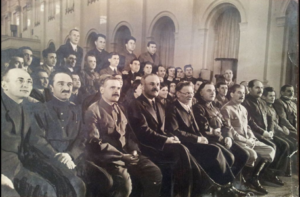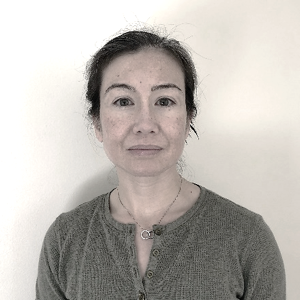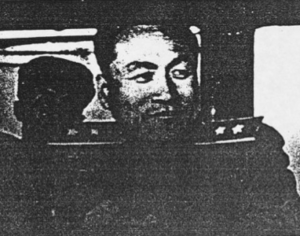Research Retrospectives

Jonathan Sicotte, Ph.D.
In the fall of 2014 and 2015, the Jacques Rossi Memorial Gulag Fellowship provided me with critical monetary support to facilitate research on the impact of state coercion in Azerbaijan and its connection to the Soviet Gulag system. For this project, I was able to gather vital archive material from the State Archive of the Russian Federation (GARF), the Russian State Archive of Socio-Political History (RGASPI), and the State Archive of the Republic of Azerbaijan (ARDA). The materials I uncovered highlighted the connections between mass detention under Mir Jafar Baghirov – then head of State Security and First Secretary of the Azerbaijani Soviet Socialist Republic (ASSR) – and the Azerbaijani oil industry. They also helped me more deeply address the profound social and economic implications of state repression in Azerbaijan both for the population of the Republic and the rest of the Soviet Union. The process began to develop in the late 1920s with the purge of remaining politicians connected to independent Azerbaijan, continued with the dekulakization campaign of 1930-1931 and culminated in the mass cleansing of the engineering and managerial staff of Azneft (the state oil trust in Azerbaijan). During the Great Purge itself, tens of thousands of citizens from across Azerbaijan were detained and exiled into the larger Gulag system.
With the critical support provided by the Fellowship, I endeavored to prove that the transfers of these individuals and families from prisons and temporary internment camps in Azerbaijan to special settlements and camps in Kazakhstan from 1930 to 1938 was a form of state violence responding in significant part to the perceived vulnerability of the economically critical oil industry in Baku. Across this period, Baku would be vital for both the Soviet’s foreign trade and domestic economic policy and Soviet security policy in Azerbaijan would continue to revolve around it.
Dr. Jonathan Sicotte is currently writing a monograph on the development of Baku and its oil industry based on his 2017 dissertation, “Baku: Oil, Violence and Identity.”

Paula Chan, M.A., M.S.L.I.S.
The Jacques Rossi Memorial Fund for Gulag Research funded my very first research in Russian archives early on during my time at Georgetown. I went to Moscow with an interest in knowledge transfer: how did Soviet investigations of Nazi concentration camps during World War II inform the Soviet approach to, and perception of, its own network of forced-labor camps? While overseas, I expanded the scope of my inquiry to encompass other elements of Soviet investigations of Nazi crimes, a shift I could not have made with confidence without examining the archival materials themselves on-site. Two years later, I have circled back for another close look at the Gulag, now that I have recognized just how many Jewish survivors of the Holocaust and Soviet collaborators with the Nazi regime were sent to work side by side in the Gulag during the final years of Stalin’s rule. Following the many interesting twists and turns dictated by the underlying source materials depends upon access to documents. In this respect in particular, I am grateful to the Rossi Fund for having supported the early stages of my research, allowing me to pursue unexpected connections between the Gulag and Soviet society at large.
Paula Chan is a Ph.D. candidate at Georgetown University and a Claims Conference Saul Kagan Fellow in Advanced Shoah Studies. Her article “Red Stars and Yellow Stars: The Soviet Investigation of Klooga Concentration Camp” was published in the fall 2019 issue of Holocaust and Genocide Studies.

Simon Belokowsky, M.A.
The Jacques Rossi Fund afforded me the opportunity to work at the State Archive of the Russian Federation [GARF] as well as the Moscow Archive of the Memorial Foundation. Influenced by scholars’ recent efforts to situate the Gulag within the broader context of the Soviet project, I wondered whether and how the cultural propaganda aimed at prisoners themselves was tailored to their particular context. These questions had been approached by other scholars for the 1920s and early 1930s, but less had (and has) been done on later periods covering the apex of the system’s extent. Ultimately, I found a lack of imagination in satirical propaganda aimed at prisoners, which deviated rather little from what was observed in other, more prosaic venues in the USSR. This encouraged me to think about prisoners’ own humor, which served an important purpose in helping inmates process the complicated social pressures of their perilous environment.
Regarding authorities’ posture toward the purpose of the Gulag system – a fraught question for historians – one of my more interesting finds was an instruction from central NKVD authorities in Moscow to camp administrators of political propaganda and education proclaiming that all prisoners should be permitted to publish work in the camp press regardless of the statute under which they were convicted. This meant that alongside common criminals, political prisoners sentenced for counterrevolutionary crimes could participate in the political education of their fellow inmates. To be sure, there was an element of exigency behind this proclamation – political prisoners tended to be the most literate segment of camp society. On the other hand, this implied that not only could all classes of offenders be rehabilitated into faithful citizens, but that they could also contribute positively to the rehabilitation of others. A more cynical interpretation would hold that higher strata of the NKVD bureaucracy understood that political prisoners were generally not the agents of treachery, which they were presented to be.
Simon Belokowsky is a Ph.D. candidate at Georgetown University. His article “Laughing on the Inside: Humor as a Lens on Gulag Society” was published in the summer 2019 issue of the Journal of Social History.

Jooeun Kim, Ph.D.
With the generous support of the Jacques Rossi Memorial fund for Gulag Research, I was able to conduct research on the North Korean Gulag and the ordeal of Soviet-Koreans. In 2017, I visited the Hoover Institute’s archive where I worked with documentation on the Soviet policy of internal isolation. In addition, I worked with materials housed in the Library of Congress. I read memoir materials and biographies of Soviet-Koreans, written in Korean. These materials were assembled in 1972 by a man called Ri Sangjo, a former DPRK ambassador to the Soviet Union. Ambassador Ri chose not return to Pyongyang after his tenure as an ambassador in Moscow and assembled the collection in an effort to counter the distorted and hagiographic history told by North Koreans who purged any Soviet-Koreans and sent to the Gulag.
While North Korean Gulag is well known for its brutality, the stories of Soviet-Korean who ended up in the system during its early development throughout the 1950s are virtually unknown, both in the United States and in South Korea. There are many heart-breaking stories, including one about a kind family man named Ko Hui-man, who was living in what was later the Soviet Far East during the Japanese colonial period and later trained to become the first ethnic Korean combat pilot in the Soviet Army. Immediately after completing his training, he volunteered to go fight in the “Internationalist Brigades” in Spain against the fascists from 1935 to 1937. He returned to the Soviet Union just in time for the first mass ethnic deportation under Stalin: the deportation of Koreans to Central Asia. Despite his service in the Internationalist Brigade, Ko was sent into internal exile in the Soviet Union for 8 years. Then, in 1945, he was summoned to Moscow to be part of a group of ethnic Koreans to return to his ethnic homeland (Korea) after its liberation from Japan to help build a socialist state. The internationalist spirit that inspired him to go to fight fascism in the skies over Spain and then to bring socialism to Korea sealed his fate, however, as it clashed with the growing nationalism of the local Korean leadership. Ko was purged and sent to the North Korean Gulag where he almost certainly perished. This is just one example among so many tragic and unjust stories, most of which we will never know.
Dr. Jooeun Kim is Stanton Nuclear Security Fellow at the Council on Foreign Relations.
